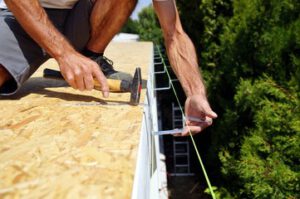There are many benefits to hiring a professional for your gutter installation. This will help you avoid falling hazards and save you time. Before you call a contractor, make sure you research their skills and experience. It will help you decide whether they’re an appropriate fit for your home. Gutter Installation Contractor can ensure that your home is properly protected from rainwater and other elements.

When you are trying to install gutters in your home, there are many things to consider. First of all, you have to make sure that the measurements are right. The wrong measurements can lead to a poor installation that will cost you money in the long run. Also, you could accidentally damage the roof. If you have never installed gutters before, it is best to leave this to a professional.
Another mistake to avoid is over-stretching the gutters. This is particularly important if the gutters are not properly pitched. When installing a gutter, be sure to set it at a steep enough pitch to allow water to drain properly. If the gutter is too flat, the water will sit in the gutter instead of flowing away. This will allow mosquitoes to breed and will reduce the life of your gutters.
You also need to ensure that your gutters are properly welded together. Faulty seams will cause them to break apart or become brittle. Furthermore, they will not be durable enough. Even if the gutters are properly welded, they may crack or fall apart when it’s exposed to harsh weather.
Another common mistake when doing the gutter installation on your own is choosing the wrong materials. Even though vinyl and other cheaper materials are easy to find, they aren’t very durable for gutters. A better choice would be metal. Copper is the gold standard, but it’s also expensive and requires specialized installation. A more affordable option would be galvalume steel or aluminum.
You should also make sure to get enough gutter hangers. If they’re too far apart, they’ll sag. This can cause water to overflow and cause damage to your home’s foundation. In addition, it can lead to a flooded basement.
Before you begin your gutter installation project, you’ll want to determine the materials you’ll need. For example, you’ll need three-inch-wide strips of aluminum. These will form the bottom of the gutter’s downspout. You’ll also need a chisel to trace the gutter’s edge. Then, use a drill or a sabre saw to cut the pieces to the proper length. When you’re done, use a hammer to drive the screws into the gutters, and you’ll need a third screw to attach the downspout outlet.
To complete your gutter installation, you’ll need the following components: inside and outside corner pieces, end caps, downspout elbows, and a quality gutter lap sealer. You’ll also need to purchase screws or nails to join the components together. You may even want to use pop rivets or sheet metal screws to fasten the gutter pieces to the house.
After determining the materials you’ll need, you’ll want to decide on the gutter installation method. You’ll need to start at one end of the roof, and work your way outward, starting with the inside corners. Regardless of which method you choose, make sure to check the safety of your roof and gutters before attempting any type of gutter installation. If you feel unsafe at any time, call a professional gutter company to do the job for you.
Depending on the type of gutter installation you’re doing, you’ll need a ladder and a spotter to keep your ladder steady. A tarp is a good idea to protect your yard from debris. Using a putty knife to smooth the silicone into the joint can be helpful as well.
Before installing gutters, make sure that you prepare them properly. Firstly, mark the center of the downspout outlet. Make sure that it is level and that there is no obstacle in the way. After marking the center of the downspout outlet, place the first section of the downspout over it. Next, use a chisel to cut a notch for the tin snips to go through.
Once you’ve marked where the downspout will go, you can install the gutter sections. Make sure that the sections are connected by straps or holes, and make sure that they fit tightly. You can then use screws or pop rivets to secure them in place. Finally, you can crimp the gutter joints with needle-nose pliers or a specialized crimping tool.
